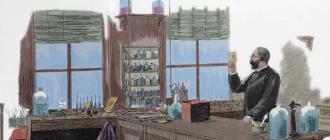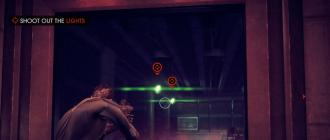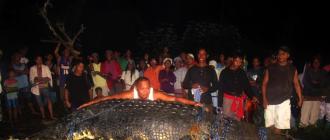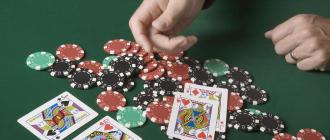Scientific citation. Citation rules in scientific work Scientific citation rules
Fundamentals of Scientific Citation: Method. a guide for students and undergraduates studying on specials. 1-23 01 04 "Psychology" / T. O. Kulinkovich. - Minsk: BSU, 2010 .-- 58 p.
(excerpt)
“An obligatory component of any scientific work is scientific citation. In scientific works, references are made to sources from which materials or individual results are borrowed, or on the ideas and conclusions of which problems, tasks, questions are developed, the study of which is devoted to the work. Such links make it possible to find relevant sources, check the accuracy of citations, and obtain the necessary information about these sources (its content, language, volume).
The use of bibliographic references in scientific works is mandatory and is used in the following cases:
When quoting fragments of text, formulas, tables, illustrations;
When borrowing provisions, formulas, tables, illustrations, etc. not in the form of a quote;
With a paraphrased, non-verbal reproduction of a fragment of someone else's text;
When analyzing the content of other publications in the text;
If necessary, the reader can be referred to other publications, where the material under discussion is given in more detail.
Missing links constitutes copyright infringement, and an incorrectly formatted link is considered a serious error. All sources given in the list of used literature must be indicated in the text of the article.
The appearance in the text of the work of citations and references that are not presented in the list of references, and vice versa, the appearance in the list of references of sources to which there are no references in the text of the work, is a gross mistake.
When evaluating the bibliographic apparatus of the work, no less attention is paid to the quality of the cited sources. The main requirements for the sources cited in the work are their authority and relevance to the topic under study. The most authoritative sources of information for scientific works are the latest scientific articles and monographs (including foreign ones). When referring to these sources, one should pay attention to the scientific qualifications of the authors, as well as to the authority of the journal in which the article is published.
In the theoretical development of a scientific problem, the student should also show familiarity with the classical works, referring to the relevant sources in the work. Information about the most famous scientific works in the field under study can be obtained in reference and educational literature, in bibliographies of scientific articles and monographs, as well as from a scientific supervisor.
Note!
· If the same material is reprinted several times, then you should refer to its latest edition. Earlier editions can only be cited when they contain material that is not included in the latest editions.
· Citation in scientific papers of educational and reference publications should be limited. You should avoid references to popular publications, as well as materials whose authorship cannot be established, even if the information provided in them corresponds to the topic of the scientific work.
· Indication of a reference to a bibliographic source in a scientific work assumes that the author of the work has personally familiarized himself with this publication and can, if necessary, support a scientific discussion (for example, when defending a scientific work) about the content of this source.
· When using theoretical provisions, ideas, proofs, research results of other authors in scientific work, it is necessary to provide links to authors and sources of information provided.
· When writing a scientific work, there are cases when it is necessary to draw the reader's attention to a large section of literary sources, it is not possible to cite references to which in the work because of their large number. Such cases are separately discussed in the text of the work, a link is given to the latest or most famous works on the topic, and the reader is advised, if desired, to turn to independent consideration of the remaining sources.
To correctly formulate references to the works of other authors in scientific work, the following rules and recommendations should be adhered to:
1. When referring to other authors, you should indicate not only the surname, but also the initials of the author. This recommendation is often ignored in educational and scientific literature, so you can find references to authors without specifying initials. If in a student work the author is cited from a secondary source, which does not indicate his initials, information about the author can be found in the list of references of the secondary source or in other sources (for example, on the Internet).
2. In scientific texts, it is customary to indicate the initials of the cited authors before the surname, and not after it.
3. It is not recommended to write the names of the cited authors in full, even if their names are well known (Z. Freud, not Sigmund Freud, etc.). The entire text of the work should be drawn up in the same style, indicating only the initials and surnames of the cited authors.
6. When quoting, make sure not to confuse the cited author with a well-known namesake and not to cite twice the researcher who changed his last name or took a pseudonym.
7. Most often, mistakes are made when women-scientists are mentioned in the works, whose surnames and initials do not allow making a conclusion about gender.
In scientific works, the most common type of citation is indirect citation, or paraphrase .
Paraphrase- retelling a quote (usually a small fragment) in your own words with a mandatory link to the source of the citation. When presenting information in your own words, distortion of the original meaning of the text is not allowed.
The use of a paraphrase in scientific work is irreplaceable in the following cases:
The original quotes are too long to be quoted directly;
It is necessary to provide generalized information with simultaneous reference to several sources;
It is necessary to summarize the content theoretical concept or the procedure and research results referenced in the work.
To support your own arguments with a reference to an authoritative source or for a critical analysis of a particular work of the press, quotations should be cited. Academic etiquette requires accurate reproduction of the quoted text, since the slightest reduction in the quoted excerpt can distort the meaning that the author has put into it.
1. A scientist is a subject of scientific work. The ethics of scientific research covers the problems associated with a) the motivation for entering science, b) with the choice of the research topic, c) with the choice of methods and means of research, verification, examination, i.e. with the main stages of the study.
a). Moral situations of moral choice, dilemmas arise already because of the imbalance of what a person comes with and what real values and norms of scientific communication he finds within the framework of a particular scientific institution or research team. Most often, the adaptation of a specialist to new functional roles, to a new microenvironment requires a significant change in his attitudes, personality restructuring. The degree of painfulness of the adaptation process largely depends on the coincidence of attitudes, personal interests with the plans of a scientific institution, a firm, as well as on the availability of reserve attitudes formed in the course of vocational training at a university.
b). When choosing a direction and topic, the behavior of a scientist research is to a large extent a consequence of the choice of a profession that has already been made once, as well as the manner in which he entered science: "from the front door" or "from the back door."
v). The choice of methods and means of research and verification is governed by the logical, technological and methodological norms for the derivation of knowledge, but this is the subject of a special science - the methodology of science. These are such norms and principles as, for example: "seek the truth", "avoid nonsense", "state clearly", "look for interesting hypotheses", "try to test hypotheses as thoroughly as possible", "be ready to start all over again", etc. .d.
2. Ethics of scientific communication.
Scientific communication takes place both directly and indirectly - through scientific publications.
Ethics of scientific publication
is the most important part of the ethics of scientific communication. The fact is that a publication acts as a unit of disciplinary knowledge, evidence of the author's belonging to a given scientific community. It is because of this that the moral guarantees of the process and stages of publication are important, which presuppose the obligatory passage of professional control (examination, review, written opinion of the official opponent during the defense of the dissertation).
Scientific publication is subject to certain norms, deviation from which is very often a deviation from the truth, as well as from the norms of law. Only what is really checked, tested, confirmed by experiment, archival materials, polls, etc. should be published. Here, such norms as conscientious attitude to the results obtained, scientific honesty are in the first place. And striving for the honor of the discoverer (for priority reasons) should not conflict with morality.
It is important to bear in mind here that scientific activity is competitive in nature. Because of this, the mechanisms of self-organization of the scientific community in some essential aspects resemble the mechanisms of the market, with the fundamental difference that the role of capital in science is played by confession colleagues. This form of capital, of course, does not lend itself to such a simple calculation as money, but like the amount of money in a country's economic system, the "total amount of recognition", so to speak, is limited, which gives rise to competition among scientists. In recent decades, a form of its calculation has been found, albeit not always fair and often criticized, but which has proven its effectiveness - the "currency unit" of recognition is the citation of the article of scientist A in the article of scientist B. The more such units A gets, the higher the level of its recognition. This symbolic capital materializes in various forms, but above all in the form of a ranking in science, which affects the likelihood of receiving a grant.
As in a market economy, the normative value system of the scientific community not only allows, but also stimulates competition between scientists. At the same time, it tries to establish the rules of fair competition and ensure the consolidation of the scientific community. How is it? Competing with colleagues in the struggle for recognition, each scientist realizes his individual interest. This interest, however, he can pursue only within the scientific community. And this encourages the scientist to treat colleagues with respect, to recognize the contribution to science of each of them and to maintain a climate of mutual trust.
Therefore, another group of scientific publication norms relates to co-authorship and citation. As a rule, gratitude and mention of all those who in one way or another helped in the implementation of this study is the most common form of correctness, tribute to assistants. It is better to thank a specific person for a specifically named contribution, and not be limited to the abstract "thank those who advice helped the birth of this work."
The ethical aspects of co-authorship arise due to the fact that the collective, group form of research prevails in modern science. And sometimes it is difficult to determine the size of the personal share of each participant. Is there or not a moral right to co-authorship in the implementation of a joint experiment, project? In order to "weigh" this share or find an algorithm for such a right in each case, sometimes special studies are needed. Therefore, it is advisable to point out certain moral rules when solving problems arising in this case.
When there is no reason to doubt such a right, an alphabetical listing of authors is usually an expression of the spirit of equal cooperation with co-authorship. More complicated are the moral issues that arise with the co-authorship of representatives of various scientific generations, as well as a subordinate and a leader. In any case, we can firmly say that the moral duty of an older comrade is to help the younger, but in a form that would not infringe on his pride and dignity. The moral rule is that a high position in the administrative-service hierarchy does not automatically give the right to co-authorship with their subordinates.
Concerning the ethics of citation, it should be recalled that cognition is a gradual, often imperceptible advancement in each narrow field of science, which would have been impossible without knowledge and use of everything achieved by predecessors in this area. Scientific progress is unthinkable without the cumulation and assimilation of existing ideas. Therefore, the important thing is the norm of obligatory reference to the source of the idea, to the predecessor.
The rules of citation express not only the requirements of logic or "technique of presentation", they are at the same time ethical and aesthetic norms, being a reflection of the general and professional culture, moral character of the author. The specificity of scientific communication lies in the fact that communication mainly occurs without personal acquaintance, it is impersonal. Having become the value of science, knowledge, as it were, loses its “fatherhood”, therefore, the theft of ideas can also occur in a depersonalized form, by “collecting” orally expressed ideas at symposia and conferences. Here the boundaries of what is permissible are determined only by the conscience of scientists. The meaning of citation is not only the search for an argument in one's own favor, but also the correct consideration of opinions and the use of the results of other scientists working in the same field.
Citations and references to other authors, the inclusion of their works in the bibliography should be justified by the content of the work, and not serve as a "curtsey" just in case to the address of possible future opponents, reviewers, etc. The moral duty of a researcher is to quote according to a strictly semantic and logical necessity.
A deviation from the moral norms of citation is the deliberate suppression of the works of some predecessors or the achievements of like-minded people. In this case, a dismissive or negative attitude towards the personality of a researcher, as a rule, is unjustifiably transferred to knowledge, to scientific results. The lack of reference to known results is also an expression of a dismissive attitude towards both the author and his work. It gives reason to think about insufficiently high qualifications, the general culture of the author and even gives reason to assume that this author is simply not familiar with the works of scientists, whose alternative opinion he did not present in the introductory part of his work.
Another group of moral situations that arise during a scientific publication is associated with peer review and the performance of an expert function by scientists. At the same time, ethical problems arise from the fact that in reality the most competent, real experts are a very narrow circle of specialists who have a professional and moral right to judge this work. Meanwhile, the reviewed work is not always directed to these specialists. With the existence of such an “invisible college” (as a group of specialists working in one narrow area constantly informing each other is usually called in the scientific community), a problem of trust arises in the “peer-reviewed-reviewer” relationship if the work is not at the right place.
Objectivity and impartiality of the reviewer is a mandatory requirement of the ethics of science, which presupposes the consciousness of one's responsibility to the scientific community and to the reviewed author. Peer review should be aimed at maximizing the solution of a scientific problem, carried out without regard to the personality and status of the author or the authority of the institution where he works. It should always be remembered that the maximum objectivity of a review is an assessment of the moral reputation of the reviewer himself.
General rules
What is citation? Quoting is called:
· Borrowing formulas, statements, illustrations, tables and other elements;
· Non-verbal, translated or paraphrased reproduction of a fragment of the text;
The most important citation rule is to accompany the quotation with a reference to a specific source from the bibliography. The absence of a link in a quote or the absence of a quote in the presence of a link is a gross error in the design of the work. For example, in the publishing house "Young Scientist" this may be a reason to return your article for revision.
1. Be sure to use quotation marks when rewriting the source text verbatim. Otherwise, such a quote will become plagiarism.
2. The text of the quote must be complete. Arbitrary shortening of the text is not allowed.
3. When referring to the author, indicate his surname and initials. The initials are placed before the surname, for example, “M.T. Kalashnikov "or" S. Hawking ". There is no need to write the names of the authors in full, even if they are well-known - enough initials.
4. Do not start a paragraph with a quote, initials or the author's surname.
In scientific works, such a type of citation is common as paraphrase... This is the name of the retelling of a quote in your own words. In this case, the reference to the author is also required, as well as the preservation of the meaning in the retelling. The paraphrase is appropriate in the following cases:
· Provision of generalized information when referring to several sources;
· A summary of a voluminous theoretical concept;
· Voluminous quotes, inapplicable for direct mention.
Change quote permissible only in special cases. As a rule, this is undesirable, but there are cases when GOST R 7.0.5_2008 "Bibliographic reference" and methodological manuals permit the introduction of copyright changes to the quotation:
1. When expanding abbreviated words into full ones. In this case, it is necessary to take the amended part of the word in square brackets.
2. When changing the case of words in a quote. A change is permissible only if the quote obeys the syntactic structure of the phrase in which it is included.
3. When citing works published before the reform of Russian spelling in 1918
4. When identifying misprints and errors in the text of the document. The error is not corrected, but a correctly spelled word in square brackets or a question mark in brackets is put.
64. FOOTNOTE: CONCEPT, FUNCTION.
A footnote is a link outside the main text to a source of information used when writing an article, or a comment. The link is created using the appropriate tags or templates that need to be inserted after the explained part of the text.
In the final text, footnotes are automatically placed in the Notes section. Also, a footnote mark (number or icon) is automatically placed after a fragment of the explained text, which connects the explained text with a footnote, and in “Notes” a return to the explained text icon is placed in front of the footnote. If you click on the footnote sign, the text will move to the footnote, if you click on the return icon, then to the explained text.
Wikipedia's MediaWiki engine has built-in support for footnotes. Footnotes can be created in an article using the tag ... And also simplified using the button of the editing panel.
Below are examples of how to insert footnote text directly in the text of an article, and at the specified place in the article (usually at the bottom), a list of all footnotes with back icons will be automatically displayed.
What types of links are there?
Exists different types links. Let's first figure out what a link might look like.
First, it can be a text hyperlink (anchor or non-anchor).
The anchor is often the search query that we are promoting (in the example, I took the title of the article as an anchor).
We will now look at some of the other types of links.
We try to increase the number of incoming links to our site (recommendations of other users) in order to increase the authority of our site in the eyes of search engines. One of our most important tasks in promoting our sites is to get recommendations from other users (external links) in paid and free ways.
And now a few words about open and closed types of links.
So, there are 2 ways to design links, footnotes:
1. At the bottom of the page (under the main text, under the strip)
2. Inside the text
Although from experience we can say that the first method is already becoming obsolete. However, some universities are using it successfully. Therefore, we will consider it in detail.
In the text, you need to place the cursor where you want to insert the drift. Then, using the Links - Insert footnote functions, a number appears automatically in superscript at the cursor position (or any character that will be selected).
The second way of formatting footnotes to bibliographic sources is simpler. You just need to put square brackets or parentheses in the text where the link is required, where you indicate the number of the source from your list of used literature, as well as the page number.
Example: Ivanov B.B. talked a lot about nature or (12, p. 135).
A comma or a period should be inside brackets between the source number and the page number - they will prompt the methodological recommendations of your university
Tip: before you include footnotes inside the text, first make a list of references (correctly structured and sorted), and only then deal with the links. Then the source numbers will be verified and will not be confused.
67. LIST OF USED SOURCES AND REFERENCES: MEANING AND DRAFTING RULES.
A list of sources used is required for any independent written work, except for an essay. It is always placed at the end of the work after the main text. The following options are used as the title: "References", "List of sources used", "Literature", "Bibliographic list", etc.
The list usually includes 3 to 7 sources. There may be more, depending on the amount of written work.
The most commonly used sequence is:
At the beginning of the list are (if any) laws, decrees, legislative acts (in alphabetical order).
Further - the rest of the printed sources in alphabetical order by the author's surname or title (if the author is not indicated).
At the end of the list are electronic resources (also in alphabetical order).
Regardless of the layout of the sources used, the numbering is continuous (from the first to the last name). Before the author's surname or the name of the source, a sequential number is put in Arabic numerals with a period, then, separated by a space, the beginning of the record.
Sources of information are located in a strict alphabet, i.e. when compiling a list, you need to focus not only on the initial letter, but also on the subsequent ones.
If the list of references contains books in a foreign language, then they are located after the books in Russian.
68. STUDENT WORKS: CONCEPT, TYPES, GENERAL DESCRIPTION.
ESSAY- a report on a specific topic, which provides for a review of the relevant literature. The abstract sets out in an abbreviated form the content of a scientific work, any book ( short review content of several books). The original meaning of the abstracts was the result of summarizing one or several books on the topic, on the basis of such materials, abstract collections are compiled.In universities, an abstract usually requires a brief disclosure of a topic. There are two types of abstract - literary (review) and methodical.
COURSE - it is independent Scientific research performed by the student in accordance with curriculum... This work is done under the guidance of a teacher. Its volume is 20 - 40 s. typewritten text. The analysis of literary data and the study of work experience in accordance with the topic, the results of pedagogical observation, experiment, processed by appropriate methods are required.
DIPLOMA - this is a graduate student research study. The implementation and defense of the graduation project is the final stage of study at the university. The thesis should in no way be a compilation, a simple transfer of information from individual monographs, textbooks, articles. It is assumed, first of all, to study the problems that have not received sufficient coverage and analysis in the scientific literature, or to use new conceptual positions and approaches when considering an already known problem. When preparing theses, one should strive to identify and introduce new sources into scientific circulation, their author's interpretation, and formulate independent conclusions and recommendations.
In the process of preparing the thesis, the student has to go through several stages. The planning of the stages of the study, their sequence does not represent a rigid scheme, it largely depends on the independent choice of the author. However, there are certain rules in this area as well. First and critical stage preparation of theses is the development and selection of topics.
Scientific writing involves the use of citations.
Citations in a scientific text- This is the transmission of someone else's speech through quotation marks in order to confirm any theoretical or practical data on the issue under study.
The basic rules for the design of quotes are as follows:
1. The quoted text should be quoted in the same grammatical form in which it is given in the source, and with the preservation of all punctuation marks. Punctuation marks are not retained only if a sentence is not cited in full. In this case, instead of the omitted text, an ellipsis is placed before the beginning of the quoted sentence, or inside it, or at the end.
For instance: N. Berdyaev wrote: "Only Russian spiritual universalism, Russian universal humanity ... and not Russian national narrow-mindedness and complacency ... can be put into the basis of the Slavic idea, as well as in general in the basis of the Russian messianic idea ...".
2. A quote placed after a colon usually begins with an uppercase letter.
For instance: L. S. Vygotsky noted: "Thought itself is born not from another thought, but from the motivating sphere of our consciousness, which encompasses our drives and needs, our interests and motives, our affects and emotions."
However, if in the original source the first word of the quotation begins with a lowercase letter, then the quotation included in the text after the colon also begins with a lowercase letter. In this case, an ellipsis must be placed before the quoted text.
For instance: I. Ilyin emphasized: "... mature philosophical experience, brought to the proper intensity, integrity and objectivity, imparts to the human spirit a number of properties, traits and abilities that manifest the authenticity of its being."(In source: "... a mature philosophical experience ...").
3. If a quote is included in the text after a subordinate union ( what, so that if, though, since and others) or after introductory structures such as as notes, as emphasizes, by remark, by opinion, then the first word of the quoted text is written with a lowercase letter, even if in the source it begins with an uppercase letter.
For instance: P. Florensky noted that "scientific speech is a tool forged from everyday language, with the help of which we master the subject of knowledge."(In source: "Scientific speech ...").
According to Vl. Solovyov, "the objective world contemplated by us is created by means of a priori forms of space, time and causality."(In source: "The objective world contemplated by us ...").
4. A quotation that is included in the text as an independent sentence after a period ending the previous sentence must start with an uppercase letter, even if the first word in the source begins with a lowercase letter.
For instance: Mastering the world around, cognition of scientific achievements is impossible without confidence in the need to acquire new knowledge, without realizing the importance of one's own development. “Despondency is the enemy of every cultivation. There can be no structure in doubt. There will be no learning in fear. Observation is a step towards justice ”(N. Roerich).(In source: "... despondency is the enemy of every cultivation ...").
5. When quoting not according to the original source, it is necessary to indicate “ Cit. on:».
For instance: V.O. Klyuchevsky justly noted: "Time strengthens the assimilated heritage with a new moral connection, historical tradition, which, acting from generation to generation, transforms the covenants and benefits inherited from fathers and grandfathers into hereditary properties and inclinations of descendants" (Quoted from: Domnikov S. D. Mother-earth and Tsar-city. Russia as a traditional society / S. D. Domnikov. - M .: Aleteya, 2002. - 672 p.).
6. Each citation included in the text of a scientific work must be accompanied by an indication of the source, placed in the list of used literature.
Examples of bibliographic footnote formatting:
[Vinnikov 2003: 20]
(Vinnikov, 2003, p. 20)
In the list of references under number 5: Vinnikov A.Z. ancient history Voronezh Territory / A. Z. Vinnikov, A. T. Sinyuk. - 2nd ed., Rev. and add. - Voronezh: Voronezh Publishing House. state University, 2003 .-- 280 p.
For more than 10 years, all Russian universities have been compulsorily checking every scientific work for plagiarism - this is the order of the Ministry of Education of the Russian Federation. The check applies not only to students (essays, term papers, diploma theses), but also to teachers (dissertations, scientific articles, professional development or obtaining certification).
If we consider the check for plagiarism superficially, but everything looks logical: you cannot copy other people's works, you need to rely only on your own knowledge. However, there is one serious snag - you can write a work yourself from the first to the last word, but it will be recognized as plagiarism. Why? Because the author used literature posted on the Internet or various databases:
- theory;
- the laws;
- statements of famous personalities;
- axioms;
- proof;
- etc.
But how can we abandon all of the above if training manuals require theory? For example, any legal work consists of citing laws and the specifics of their application in a given situation. And scientific work in a technical specialty cannot do without axioms, proofs of theories, etc. It turns out a vicious circle ...
How to properly arrange borrowing
If you ask yourself the question of correct citation and search for information on the Internet, you will find several tips from experienced students at once:
- highlight borrowings with quotes;
- make footnotes at the bottom of the page (indicate the source);
- indicate the author and publish information separated by a colon;
- etc.
Do you think it all works in practice? Unfortunately, we will have to disappoint you.
At the moment, there are no ways to highlight citations so that validation services do not reduce the percentage of uniqueness. No quotes, footnotes, or parentheses will help you! Nothing!
If you want to be sure, you can try all the methods. But we warn you that you are only wasting your time.
There is an option only for journalists and copywriters who check their texts on their own - some verification services allow you to manually exclude sources.
But this will not help students and researchers:
- Verification services for universities do not rule out anything.
- They are automated and do not allow outside interference.
The authors of all popular anti-plagiarism programs claim that they are developing citation mechanisms and will soon implement them. And some have even launched test versions, but they just forgot to say that nothing works yet - all quotes still negatively affect the percentage of uniqueness.
2-3 years have passed since the first statements on the legalization of citation, and things are still there. This means that you need to learn to bypass anti-plagiarism. Moreover, in most cases this is not a trick, but rather a necessity and restoration of justice.
Agree, I don't want to lose budget place, take the exam again or serve in the army due to the incompetence of the verification services.
- How to reduce the percentage of plagiarism when citing.
- How to check a scientific work for uniqueness.
- How to eliminate borrowing guaranteed.
Learning to quote correctly
You already know that all borrowings will reduce the final percentage of uniqueness, but you cannot do without them. So your task is to minimize plagiarism.
Here are the important rules:
- Shorten the quote. Leave only the most important thing, ignoring introductory constructions, "water", additional explanations. The less you copy, the better.
- Don't copy huge paragraphs. Almost every scientific definition has several wordings - choose the laconic one.
- Dilute borrowings with unique text. Took a quote - supplement it with your comments or reflections, and only then move on to the next one.
- Increase your workload. If in the theoretical part you had to copy too much text, then "stretch" the practice. The more unique content in the work, the higher the total percentage of originality.
- Transfer borrowings to applications. Some instructors check text only, and consider attachments as separate, stand-alone material.
Sometimes you can achieve a high percentage of uniqueness just by following these simple rules - try it. If it doesn't help, then there are other ways to bypass anti-plagiarism.
Checking the work
Remember once and for all: you do not need to wait for the uniqueness check at the university - check it first on your own. If the university rejects the text, then only a few days will remain to eliminate the comments - you may simply not be in time. And if you know the percentage in advance, then the chances of having time to fix everything are much higher.
Each university works with a strictly defined verification service - you need to focus on its results. But not everything is so simple, there are snags:
- the service may not be available to students;
- you need to pay for the check;
- the system does not provide a report, but only reports the percentage;
- no links to primary sources;
- you can download only small texts, but you cannot download large scientific works;
- etc.
Therefore, it is more logical to use free universal systems, which take into account the algorithms of all modern anti-plagiarism. For example, our site will suit you.
Firstly, everything is automated, and the check will take no more than a minute if there is no queue.
Secondly, you can upload a text up to 200,000 characters or a document up to 20 MB. Believe me, this is enough for scientific work.
Thirdly, you can additionally select other systems (including the "closed" "Antiplagiat.VUZ").

Fourth, you will receive a detailed report, which will mark all the borrowed fragments.

Fifth, find out the primary sources.

We increase the uniqueness
The percentage of uniqueness is below the norm, and there are too many borrowings to rewrite on your own? There are 2 options:
- Coding.
- Professional rewriting.
Coding is an intervention in the program code of a document. You yourself indicate the verification service and the desired percentage of the originality of the text, and after 5 minutes you will get a unique work.
The cost is only 7 rubles per page.
Professional rewriting - handmade by our specialists. In 3 days they will completely rewrite the text, and it will become unique for any anti-plagiarism.
The cost is 100 rubles per page.
Already 300,000 students have used our services and successfully defended. Contact us - we will be happy to help you too!





